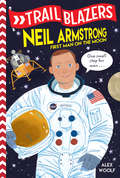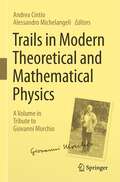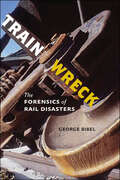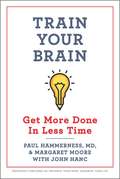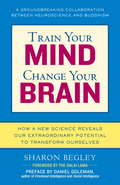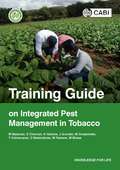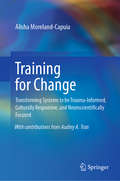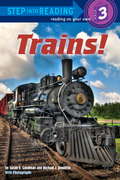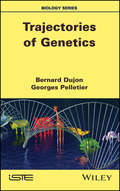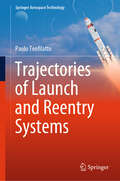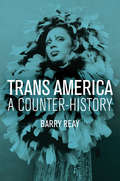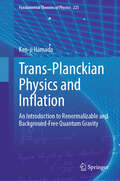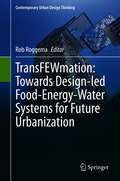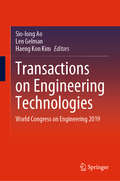- Table View
- List View
Trailblazers: A Life with Chimps (Trailblazers #3)
by Anita GaneriMeet history's game changers! This biography series is for kids who loved Who Was? and are ready for the next level.In July 1960, Jane Goodall went into the wilderness in Tanzania to study chimpanzees. For years she camped out with the chimps, observing their behavior and making amazing discoveries! Jane had always been fascinated by animals and knew she wanted to make learning more about them her life's work. Find out how this girl who loved animals became one of history's greatest trailblazers!Trailblazers is a biography series that celebrates the lives of amazing pioneers, past and present, from all over the world.
Trailblazers: First Man on the Moon (Trailblazers #1)
by Alex WoolfMeet history's game changers! This biography series is for kids who loved Who Was? and are ready for the next level.On July 20, 1969, the whole world was watching Neil Armstrong. He was the first person ever to set foot on the moon! But how did he achieve such an amazing feat? From a childhood spent building model planes to an early career as a test pilot, Neil was always fascinated by aviation. Find out how this boy who loved planes became one of history's greatest trailblazers!Trailblazers is a biography series that celebrates the lives of amazing pioneers, past and present, from all over the world.
Trailblazers: The Greatest Mind in Physics (Trailblazers #5)
by Paul VirrMeet history's game changers! This biography series is for kids who loved Who Was? and are ready for the next level.Albert Einstein is the most famous scientist of all time. His theories form the basis of physics today. Find out how the boy who taught himself calculus at age twelve became one of history's greatest trailblazers!Trailblazers is a biography series that celebrates the lives of amazing pioneers, past and present, from all over the world.
Trails in Modern Theoretical and Mathematical Physics: A Volume in Tribute to Giovanni Morchio
by Alessandro Michelangeli Andrea CintioThis book celebrates the life and work of the late Giovanni Morchio (1944–2021). It features scientific and anecdotal contributions written by his former colleagues, co-authors, and students, as well as senior scientists who were active witnesses to the dramatic advances in physics and in mathematics that took place during his 50-year-long career. The volume begins with a biographical introduction, detailing Giovanni Morchio’s life and his role as a physicist, mathematician, teacher, and scientist. The core of the book covers a vast spectrum of ideas, reflecting Dr Morchio’s scientific interests. Each chapter develops a specific topic of modern research, ranging from quantum mechanics and quantum field theory to additional themes such as the connection between general relativity and Newtonian gravitation. Every contribution provides a historical retrospective, a survey of advances, an outlook of future perspectives and challenges, and an updated bibliography. The last part collects the authors’ recollections of their professional and personal interactions with Dr Morchio, in recognition of his deep achievements, his exceptional pedagogical qualities, and his praiseworthy social and pro bono commitment. Authored by physicists of international calibre covering a broad range of subjects, the book will be a valuable reference for researchers and students of theoretical and mathematical physics.
Train Wreck: The Forensics of Rail Disasters
by George BibelGripping forensic tales explain how and why trains crash.Trains are massive—with some weighing 15,000 tons or more. When these metal monsters collide or go off the rails, their destructive power becomes clear. In this book, George Bibel presents riveting tales of trains gone wrong, the detective work of finding out why, and the safety improvements that were born of tragedy. Train Wreck details numerous crashes, including 17 in which more than 200 people were killed. Readers follow investigators as they sift through the rubble and work with computerized event recorders to figure out what happened. Using a mix of eyewitness accounts and scientific explanations, Bibel draws us into a world of forensics and human drama.Train Wreck is a fascinating exploration of• runaway trains• bearing failures• metal fatigue• crash testing • collision dynamics• bad rails
Train Your Brain: Get More Done In Less Time
by Margaret Moore Paul Hammerness M.D.IF YOU’VE EVER LOST YOUR KEYS, MISSED AN APPOINTMENT OR BEEN DISTRACTED BY A FRIVOLOUS EMAIL, THEN THIS BOOK IS FOR YOU.The key to a less hectic, less stressful life is not in simply organizing your desk, but organizing your mind. Dr. Paul Hammerness, a Harvard Medical School psychiatrist, describes the latest neuroscience research on the brain’s extraordinary built-in system of organization. Margaret Moore, an executive wellness coach and codirector of the Institute of Coaching, translates the science into solutions.This remarkable team shows you how to use the innate organizational power of your brain to make your life less stressful and more productive and rewarding. You’ll learn how to:¥ Regain control of your frenzy¥ Embrace effective uni-tasking (because multitasking doesn’t work)¥ Fluidly shift from one task to another¥ Use your creativity to connect the dotsThis groundbreaking guide is complete with stories of people who have learned to stop feeling powerless against multiplying distractions and start organizing their lives by organizing their minds.
Train Your Mind, Change Your Brain: How a New Science Reveals Our Extraordinary Potential to Transform Ourselves
by Sharon BegleyIs it really possible to change the structure and function of the brain, and in so doing alter how we think and feel? The answer is a resounding yes. In late 2004, leading Western scientists joined the Dalai Lama at his home in Dharamsala, India, to address this very question-and in the process brought about a revolution in our understanding of the human mind. In this fascinating and far-reaching book, Wall Street Journal science writer Sharon Begley reports on how cutting-edge science and the ancient wisdom of Buddhism have come together to show how we all have the power to literally change our brains by changing our minds. These findings hold exciting implications for personal transformation. For decades, the conventional wisdom of neuroscience held that the hardware of the brain is fixed and immutable-that we are stuck with what we were born with. As Begley shows, however, recent pioneering experiments in neuroplasticity, a new science that investigates whether and how the brain can undergo wholesale change, reveal that the brain is capable not only of altering its structure but also of generating new neurons, even into old age. The brain can adapt, heal, renew itself after trauma, and compensate for disability. Begley documents how this fundamental paradigm shift is transforming both our understanding of the human mind and our approach to deep-seated emotional, cognitive, and behavioral problems. These breakthroughs show that it is possible to reset our happiness meter, regain the use of limbs disabled by stroke, train the mind to break cycles of depression and OCD, and reverse age-related changes in the brain. They also suggest that it is possible to teach and learn compassion, a key step in the Dalai Lama's quest for a more peaceful world. But as we learn from studies performed on Buddhist monks, an important component in changing the brain is to tap the power of mind and, in particular, focused attention. This is the classic Buddhist practice of mindfulness, a technique that has become popular in the West and that is immediately available to everyone. With her extraordinary gift for making science accessible, meaningful, and compelling, Sharon Begley illuminates a profound shift in our understanding of how the brain and the mind interact. This tremendously hopeful book takes us to the leading edge of a revolution in what it means to be human. From the Hardcover edition.
Training Guide on Integrated Pest Management in Tobacco
by Keith A Holmes Melanie Bateman Julien Grunder Erica Chernoh Manfred GrossriederThis book provides the necessary tools to design and implement training programmes on Integrated Pest Management in tobacco. It presents a core training package with detailed curricula to address all aspects of responsible management of Crop Protection Agents (CPA). Background information to support technical understanding is included in addition to activity descriptions and facilitator notes ideal for guiding trainers. Step-by-step support is provided to direct all stages of the implementation of the training programme, which is highly participatory and activity driven. This guide can be used to help training teams to build up knowledge and commitment among field technicians and farmers by providing material to address training needs and offering guidance on how to adapt the core material to local conditions through the national training programmes
Training Law Enforcement Officers
by Rick D. GiovengoThis how-to guide covers every aspect of law enforcement training, from training academy administration, to designing curricula, to identifying and utilizing qualified instructors. Using the latest methodologies, technologies, and best practices, Training Law Enforcement Officers gives law enforcement administrators, training specialists, instructors, instructional systems designers, and academy directors a proven way to conduct training for all levels of practitioners, from basic law enforcement to high-risk law enforcement. At a time when scrutiny of law enforcement officers is on the rise, Training Law Enforcement Officers is an essential guide for those criminal justice practitioners seeking to minimize police error and make today’s police force the best that it can be.
Training for Change: Transforming Systems to be Trauma-Informed, Culturally Responsive, and Neuroscientifically Focused
by Alisha Moreland-CapuiaThis book offers an integrated training and coaching system to facilitate change in systems that serve youth (education, healthcare, and juvenile justice). The integrated training and coaching system combines brain development, cultural responsivity, and trauma-informed practices. The book provides a comprehensive overview of the neurobiology of fear, brain development, trauma, substance use, and mental health, structural bias and environmental factors that pose a threat to healthy brain development. The book employs practical applications/recommendations and case examples that help solidify understanding of key concepts. Each chapter begins with a set of objectives and interactive exercises that builds on the next, thoughtfully challenging the reader (and giving specific, practical ways for the reader) to apply the information presented with the goal of "change". The text is written from the perspective of a trauma-informed addiction psychiatrist who has effectively facilitated systems change. Topics featured in this book include:Common threats to healthy brain development.The neurobiology of trauma.Applying trauma-informed practices and approaches.Cannabis and its impact on the brain.Labeling theory and implicit bias.Exploring the connection between fear and trauma.Rehabilitation versus habilitation.Managing stress through mindfulness. Training for Change will be of interest to graduate and advanced undergraduate students and researchers in the fields of cognitive psychology, criminology, public health, and child and adolescent development as well as parents, teachers, judges, attorneys, preventative medicine and pediatric providers.
Trains! (Step into Reading)
by Michael Doolittle Susan E GoodmanA Step 3 reader (Reading on Your Own) that introduces trains of all shapes and sizes doing what they do best: hauling freight, carrying passengers, and zooming at speeds close to 400 miles per hour! Readers will encounterthe Jacobite--a Scottish train that plays the Hogwarts Express in the Harry Potter films. They will learn about the great steam locomotives that crossed the United States, joining east and west in 1869. They will travel the world, visiting Japanese commuter trains so busy that men called "pushers" pack people in! And they will learn about the different technologies--steam, diesel, electric, and electromagneticthat continue to make trains such an important part of our modern world. Illustrated with full color and black & white photos.From the Trade Paperback edition.
Trait-Mediated Indirect Interactions
by Oswald J. Schmitz Takayuki Ohgushi Robert D. HoltThere is increasing evidence that the structure and functioning of ecological communities and ecosystems are strongly influenced by flexible traits of individuals within species. A deep understanding of how trait flexibility alters direct and indirect species interactions is crucial for addressing key issues in basic and applied ecology. This book provides an integrated perspective on the ecological and evolutionary consequences of interactions mediated by flexible species traits across a wide range of systems. It is the first volume synthesizing the rapidly expanding research field of trait-mediated indirect effects and highlights how the conceptual framework of these effects can aid the understanding of evolutionary processes, population dynamics, community structure and stability, and ecosystem function. It not only brings out the importance of this emerging field for basic ecological questions, but also explores the implications of trait-mediated interactions for the conservation of biodiversity and the response of ecosystems to anthropogenic environmental changes.
Traits and Reproduction: The Genetics of Spider Silk, Investigation Notebook with Article Compilation
by The Lawrence Hall of ScienceNIMAC-sourced textbook
Traits and Reproduction: The Genetics of Spider Silk, Investigation Notebook with Article Compilation [Grade 6]
by The Lawrence Hall of ScienceNIMAC-sourced textbook
Traits of Living Things, My Science Notebook
by Sangari Research Development CenterNIMAC-sourced textbook
Trajectories of Genetics
by Bernard Dujon Georges PelletierAs genetics becomes increasingly important in our everyday environment, misinterpretation of its scientific foundation leads to mixed feelings of hope and fear about the potential of its applications. Trajectories of Genetics uncovers the many facets of genetics - from humans to animals, plants, and the microscopic world through more than a century of scientific progress. It summarizes the evolution of ideas as the organization and functioning of genetic material has become clearer. The book analyzes how genetic information – transmitted from generation to generation in nucleic acids – enables the fulfillment of biological functions and the evolution of the living world. It illustrates current developments in many areas: the improvement of species of agronomic interest, an increased understanding of microbial worlds, the management of genetic pathologies and the synthesis of new forms of life.
Trajectories of Launch and Reentry Systems (Springer Aerospace Technology)
by Paolo TeofilattoThis book examines ascent trajectories of space launch vehicles and re-entry trajectories of space capsules. The decommissioned SCOUT is used as a reference launcher and the reader will be introduced to various and detailed aspects of a launch vehicle that are not generally available in the literature, since this information is limited to internal industry and agency reports. The SCOUT data are used here as a study case and the reader will be able to generate a complete numerical code using the general equations of flight introduced in different reference systems, including the time-dependent parameters representing the launcher and its environment with a high degree of accuracy. The guidance parameters for injection into orbits of different semiaxes, eccentricities and inclinations are determined by guessed values obtained by original analytical formulae. These formulae allow a fast and sufficiently accurate design of the rocket trajectory within the atmosphere; in the exo-atmospheric flight closed form solutions of the optimal problem of injection into orbit are provided. The second part of the book deals with re-entry trajectories. Basic analytical formulae for ballistic reentry are presented to evaluate the reentry trajectory and the capsule design in terms of critical parameters such as temperature and load peak. Entry corridors for ballistic reentry trajectories are then determined for various planets with atmospheres. The effect of lift is analysed to increase the entry corridors and guide the capsule to a target landing point. Autonomous and real-time guidance algorithms are developed for capsule of low aerodynamic efficiency and winged re-entry vehicles.
Trajectory Anomalies in Interplanetary Spacecraft
by Frederico FranciscoThis thesis presents fundamental work that explains two mysteries concerning the trajectory of interplanetary spacecraft. For the first problem, the so-called Pioneer anomaly, a wholly new and innovative method was developed for computing all contributions to the acceleration due to onboard thermal sources. Through a careful analysis of all parts of the spacecraft Pioneer 10 and 11, the application of this methodology has yielded the observed anomalous acceleration. This marks a major achievement, given that this problem remained unsolved for more than a decade. For the second anomaly, the flyby anomaly, a tiny glitch in the velocity of spacecraft that perform gravity assisting maneuvers on Earth, no definitive answer is put forward; however a quite promising strategy for examining the problem is provided and a new mission is proposed. The proposal largely consists in using the Galileo Navigational Satellite System to track approaching spacecraft, and in considering a small test body that approaches Earth from a highly elliptic trajectory.
Trans America: A Counter-History
by Barry ReayTrans seems to be everywhere in American culture. Yet there is little understanding of how this came about. Are people aware that there were earlier periods of gender flexibility and contestability in American history? How well known is it that a previous period of trans visibility in the 1960s and early 1970s faced a vehement backlash right at the time that trans, in the form of what was then termed transvestism and transsexuality, seemed to be so ascendant? Was there transness before transsexuality was named in the 1950s and transgender emerged in the 1990s? Barry Reay explores this history: from a time before trans in the nineteenth century to the transsexual moment of the 1960s and 1970s, the transgender turn of the 1990s, and the so-called tipping point of current culture. It is a rich and varied history, where same-sex desires and identities, cross-dressing, and transsexual and transgender identities jostled for recognition. It is a history that is not at all flattering to US psychiatric and surgical practices. Arguing for the complexity of a trans past and present, Trans America will be a groundbreaking work for the trans community, as well as anyone interested in the history of medicine, sexuality, psychology and psychiatry.
Trans-Planckian Physics and Inflation: An Introduction to Renormalizable and Background-Free Quantum Gravity (Fundamental Theories of Physics #26)
by Ken-ji HamadaThis book comprehensively describes recent developments in the research of renormalizable quantum gravity, focusing on its application to physics beyond the Planck scale, particularly in inflationary cosmology. It challenges the notion that the Planck scale is an impassable barrier, addressing issues such as singularity, renormalizability, unitarity, time, primordial fluctuations, and the cosmological constant. To describe the trans-Planckian world, it is necessary to break away from the view of graviton scattering and carry out the quantization of spacetime itself. Utilizing conformal field theory techniques to achieve background freedom, the book presents a renormalizable quantum theory of gravity that overcomes the Planck-scale wall. Historically, discussions on renormalizability of gravity declined due to ghost issues. However, ghosts are essential in gravitational systems where the total Hamiltonian/momentum vanishes strictly, for aspects such as cosmic entropy, the formation of the universe, and gravitational objects. Quantum gravity approaches known in recent years often break diffeomorphism invariance or sacrifice renormalizability to eliminate ghosts. In contrast, this book presents a novel attempt which maintains that these are guiding principles even in the trans-Planckian domain, but constrains ghosts to be unphysical. The renormalizability implies a new scale that leads to a quantum gravity inflation scenario with a spacetime phase transition as the Big Bang. This book offers fresh insights into the trans-Planckian physics for graduate students and researchers.
TransFEWmation: Towards Design-led Food-Energy-Water Systems for Future Urbanization (Contemporary Urban Design Thinking)
by Rob RoggemaThis book discusses a spectrum of approaches to designing the food-energy-water nexus at different spatial-urban scales. The book offers a framework for working on the FEW-nexus in a design-led context and integrates the design of urban neighbourhoods and regions with methodologies how to simultaneously engaging residents and stakeholders and evaluating the propositions in a FEW-print, measuring the environmental impact of the different designs. The examples are derived from on the ground practices in Sydney, Tokyo, Detroit, Amsterdam and Belfast.
Transactions on Engineering Technologies: World Congress on Engineering 2018 (Lecture Notes In Electrical Engineering Ser. #275)
by Sio-Iong Ao Len Gelman Haeng Kon KimThis volume contains a selection of revised and extended research articles written by prominent researchers participating in The 26th World Congress on Engineering (WCE 2018) which was held in London, U.K., July 4-6, 2018. Topics covered include engineering mathematics, electrical engineering, communications systems, computer science, chemical engineering, systems engineering, manufacturing engineering, and industrial applications. With contributions carefully chosen to represent the most cutting-edge research presented during the conference, the book contains some of the state-of-the-art in engineering technologies and the physical sciences and their applications, and serves as a useful reference for researchers and graduate students working in these fields.
Transactions on Engineering Technologies: World Congress on Engineering 2019 (Lecture Notes In Electrical Engineering Ser. #275)
by Sio-Iong Ao Len Gelman Haeng Kon KimThis book contains a selection of research articles written by prominent researchers participating in The 27th World Congress on Engineering (WCE 2019) which was held in London, UK, July 3–5, 2019. Topics covered include engineering mathematics, electrical engineering, communications systems, computer science, chemical engineering, systems engineering, manufacturing engineering, and industrial applications. With contributions carefully chosen to represent the most cutting-edge research presented during the conference, the book contains some of the state of the art in engineering technologies and the physical sciences and their applications and serves as a useful reference for researchers and graduate students working in these fields.
Transactions on Engineering Technologies: World Congress on Engineering and Computer Science 2017 (Lecture Notes In Electrical Engineering #275)
by Sio-Iong Ao Haeng Kon Kim Mahyar A. AmouzegarThis volume contains a selection of revised and extended research articles written by prominent researchers participating in a large international conference on Advances in Engineering Technologies and Physical Science which was held in San Francisco, California, USA, October 25-27, 2017. Topics covered include engineering mathematics, electrical engineering, communications systems, computer science, chemical engineering, systems engineering, manufacturing engineering, and industrial applications. With contributions carefully chosen to represent the most cutting-edge research presented during the conference, the book contains some of the state-of-the-art in engineering technologies and the physical sciences and their applications, and serves as a useful reference for researchers and graduate students working in these fields.
Transactions on Engineering Technologies: World Congress on Engineering and Computer Science 2018 (Lecture Notes In Electrical Engineering Ser. #275)
by Sio-Iong Ao Haeng Kon Kim Mahyar A. AmouzegarThis book features a selection of revised and extended research articles written by prominent researchers who participated in the 26th World Congress on Engineering and Computer Science (WCECS 2018), held in San Francisco, USA, on October 23–25, 2018. Topics covered include engineering mathematics, electrical engineering, communications systems, computer science, chemical engineering, systems engineering, manufacturing engineering and industrial applications. With contributions carefully chosen to represent the most cutting-edge research presented at the conference and highlighting the state of the art in engineering technologies and the physical sciences and their applications, the book is a valuable reference resource for graduate students and researchers working in these fields.

